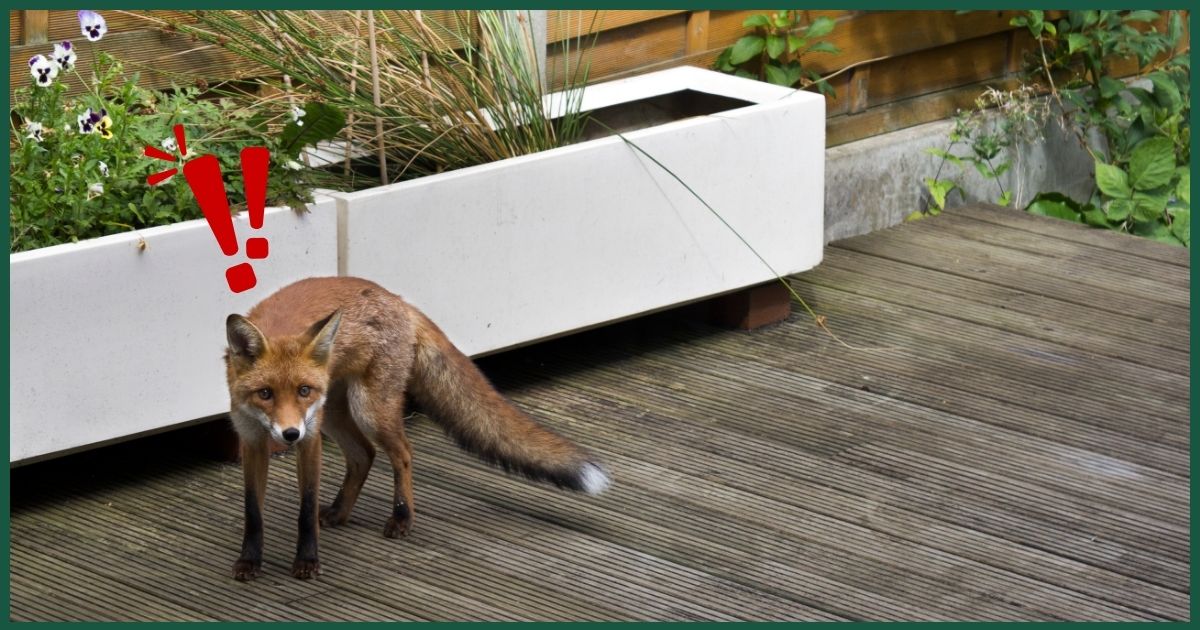How to Keep Foxes Out of Your Garden: Effective Tips and Strategies
Foxes, with their curious nature and adaptability, often find gardens irresistible. Attracted by the availability of food, shelter (such as garden sheds), and intriguing scents, these nocturnal animals can quickly become unwelcome visitors.
Foxes can cause significant disruptions by digging up flower beds, raiding compost heaps, and rummaging through rubbish bins, leaving a trail of mess and damage in their wake. Additionally, they can cause damage to garden furniture, gnawing and scratching at items left outside.
Their presence can also disturb pets and other wildlife, creating a less serene environment. Understanding why foxes are drawn to gardens and the problems they can cause is crucial for effective deterrence. In this article, we will explore practical strategies to keep foxes out of your garden, helping you maintain a peaceful and beautiful outdoor space.
Understanding Fox Behaviour
Foxes are nocturnal animals that exhibit fascinating behaviours centred around their diet and need for shelter. They are often active at night, foraging for food and looking for secure dens to raise their cubs.

Fox Diet and Food Sources
Foxes have an omnivorous diet which allows them to thrive in different environments. They often scavenge for food in urban gardens. Common food sources include small mammals, birds, and insects such as earthworms and grubs. In built-up areas, they might be attracted to rubbish bins and compost heaps.
They are opportunistic feeders and will eat fruits, vegetables, and carrion when available. Their varied diet helps them adapt to seasonal changes in food availability.
Denning and Shelter Needs
A fox's den, often called an "earth," is usually a burrow or a sheltered space like under a garden shed. These places provide a secure environment for raising their cubs. Foxes are adept diggers, creating dens in places where the ground is soft and easily excavated.
During denning season, they will look for areas that offer both safety from predators and proximity to food sources. Foxes may establish multiple dens within their territory, using them to avoid threats and extreme weather conditions. This behaviour is crucial for their survival, particularly in urban settings where they need to navigate human activity. To deter them, securing potential den sites and removing food attractants is essential.
Fundamental Garden Management
Proper garden management is crucial in deterring foxes. Maintaining a tidy garden and correctly securing waste can significantly reduce the chance of foxes finding your garden attractive.

Keeping Your Garden Tidy
A tidy garden offers fewer opportunities for foxes to find food and shelter. Regularly clear away fallen fruit, as this can be a major food source for foxes.
Keep your lawn mowed and bushes trimmed. This reduces hiding spots and makes your garden less inviting. Check for any burrows or dens and fill them in to prevent foxes from settling.
Removing bird food and feeding stations in the evening can also help. Foxes are often drawn to these food sources that attract other small animals.
Secure Waste and Compost Bins
Ensuring waste and compost bins are secure is essential. Foxes are notorious for rummaging through bins in search of food. Use bins with secure lids to prevent them from accessing the contents.
Place bricks or heavy objects on top of bin lids. This adds extra security. Avoid leaving trash bags outside overnight as they can easily be torn open.
For compost bins, use fox-proof designs that have meshed bottoms and secured lids. This prevents foxes from digging their way in from underneath.
Protecting Livestock and Pets
Livestock and pets are often at risk in areas with fox activity. For chickens and other small animals, ensure that coops and runs are robustly built. The fencing should be dug into the ground to prevent foxes from digging under.
Use strong wire mesh and secure it properly. Consider electric fencing if foxes are persistent. Always bring pet food inside after feeding, as leftover food can attract foxes.
For domestic pets, supervise their outdoor time, especially during dawn and dusk when foxes are most active. Small pets should not be left outside unattended.
By following these garden management practices, you can significantly reduce the risk of foxes entering your garden and causing trouble.
Physical Barriers and Garden Modifications
Creating effective physical barriers and making strategic modifications to a garden can help keep foxes out. Key approaches include installing proper fencing and walls, using prickly plants and shrubs, and reinforcing ponds and flowerbeds to make them less accessible and appealing to foxes.

Effective Fencing and Walls
Installing sturdy fencing around the garden perimeter is crucial. Foxes can jump up to four feet and climb over seven feet, so fences should be at least six feet high and have an overhang to prevent climbing. Burying the fence at least a foot underground can prevent foxes from digging underneath.
Materials to consider:
- Wire Mesh: Strong and durable, with a minimum wire diameter of 2mm.
- Wooden Panels: Solid barriers that can be combined with wire mesh for added security.
Brick or stone walls can also be effective. Ensuring there are no gaps or weaknesses in the structure is essential. Additionally, installing a motion sensor at the top of the fence can deter foxes with sudden light or sound.
Using Prickly Plants and Shrubs
Incorporating prickly plants and shrubs around the garden can make the area less appealing to foxes. These plants create natural barriers that are difficult and uncomfortable for foxes to navigate.
Recommended plants:
- Holly: With its sharp leaves, it serves as an excellent deterrent.
- Berberis: Known for its thorny branches and colourful foliage.
- Roses: Thorny stems can also help in keeping foxes at bay.
Planting these around the perimeter, near potential entry points, or at the base of fences can be particularly effective. Utilising mature trees and dense shrubbery can add extra layers of deterrence.
Reinforcing Ponds and Flowerbeds
Ponds and flowerbeds can attract foxes looking for food or water. Securing these areas can prevent them from becoming regular visit spots. Pond netting can be used to cover water surfaces, deterring foxes from accessing the water.
Steps to take:
- Install Pond Netting: Prevents access and protects fish and plants.
- Edge Protection: Use hardscape materials like rocks or bricks to make edges difficult to dig around.
For flower beds, consider raised beds with protective exteriors. Adding a layer of sharp gravel or mulch can also discourage digging. Regularly check for dug-up areas and fill in any holes promptly.
Natural Deterrents and Repellents
Using natural deterrents and repellents can be an effective method to keep foxes out of your garden. These strategies employ strong smells and sudden movements or noises to discourage foxes from entering and remaining in your garden.

The Power of Smells: Garlic, Chilli, and More
Foxes have a particularly sensitive sense of smell, making certain strong odours highly effective as repellents. Garlic and chilli pepper are popular choices. To create a fox repellent spray, mix crushed garlic cloves or ground chilli with water and apply it around the perimeter of the garden. This can make the area less appealing to foxes.
Cayenne pepper can also be effective. Sprinkle it directly onto the soil or mix it with water to spray around. Coffee grounds and citrus peels have been reported as being unpleasant to foxes, so scattering these items can help deter them. Regular reapplication is necessary, especially after rain, to maintain the effectiveness of these natural deterrents.
Utilising Water Sprayers and Sprinklers
Motion-activated water sprayers and sprinklers can startle foxes and make your garden an uncomfortable place for them. When a fox comes close, the sensor triggers a sudden burst of water, scaring the animal away. This method is not only humane but also effective for training foxes to avoid your garden.
Products like the Scarecrow device combine a motion sensor with a water sprinkler, activating whenever movement is detected. Consistent use of such devices can condition foxes to associate your garden with an unpleasant experience, effectively deterring them. Regular maintenance and checks are important to ensure these devices continue to function properly.
Technological Solutions and Strategies
Combining technology with traditional methods can significantly enhance efforts to keep foxes out of your garden. Motion sensors, security lighting, and acoustic deterrents play a crucial role in deterring these animals effectively and humanely.

Motion Sensors and Security Lighting
Motion sensors and security lights are effective tools for deterring foxes. Motion sensor lights are designed to activate whenever movement is detected. This sudden burst of light startles the fox, making it feel unsafe and prompting it to leave the area. This method reduces the likelihood of foxes causing damage to the yard.
Using different types of lighting, such as LED or solar-powered lights, ensures flexibility and environmental friendliness. It's important to place these lights strategically in common entry points or areas frequented by foxes. A well-placed motion sensor light can effectively cover a considerable outdoor area, making it a valuable addition to any garden.
Acoustic Deterrents: The Impact of Noise
Acoustic deterrents, utilising loud noises, create an unfavourable environment for foxes. These devices emit high-frequency sounds that are unpleasant to a fox’s sensitive ears. Sound deterrents can cover a large area and are often used in combination with other strategies for better results.
Set these devices in places where foxes are frequently spotted. Adjusting the settings to vary the noise can prevent foxes from getting accustomed to the sound. Continuous use of noise as a deterrent helps maintain an environment that discourages foxes from returning, thus contributing to safer and more secure garden spaces.
By integrating these technological solutions, homeowners can achieve a more effective and lasting way of keeping foxes at bay.




